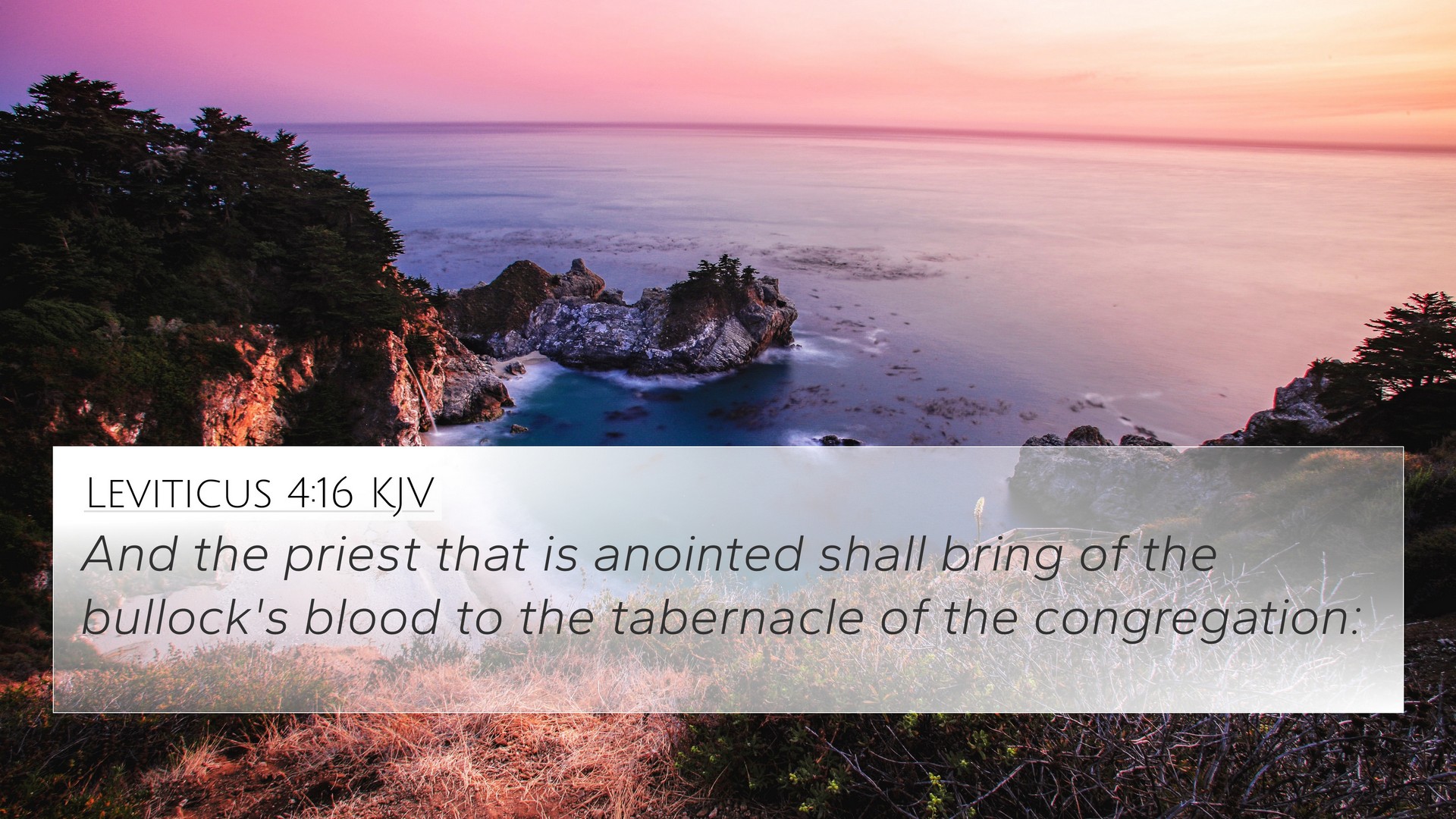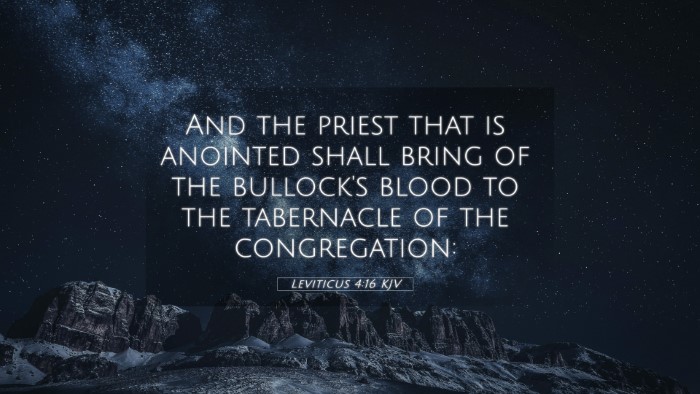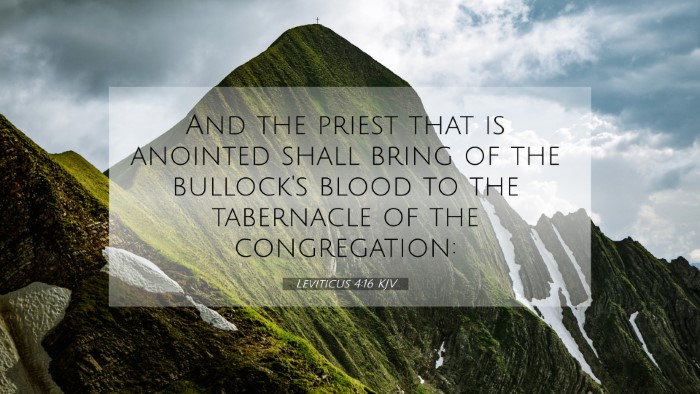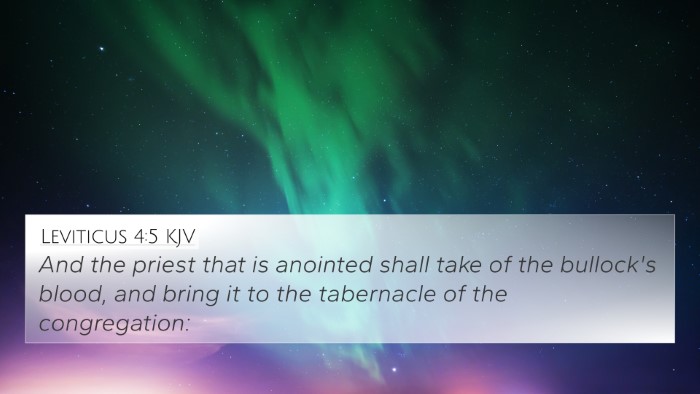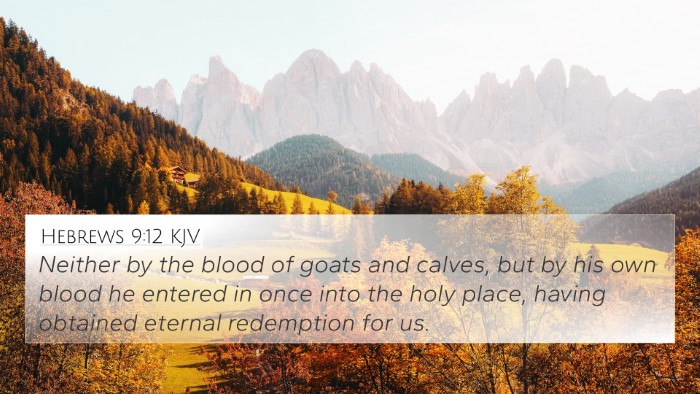Understanding Leviticus 4:16
Leviticus 4:16 discusses the role of the high priest in the context of sin offerings. It emphasizes the gravity of sin and the necessary steps for atonement. This verse provides insight into the sacrificial system central to the Israelite worship and the foreshadowing of Christ’s ultimate sacrifice.
Verse Context
This verse appears within a larger passage concerning sin offerings for unintentional sins (Leviticus 4:1-35). Here, specific instructions are given on how the high priest is to prepare for the atoning sacrifice that would help the people reconnect with God after sinning.
Commentary Insights
Matthew Henry Commentary
Matthew Henry highlights the importance of the high priest in making atonement for the people. He notes that the high priest must bring the sin offering, which signifies that sin has serious consequences. Through this sacrificial system, the gravity of sin is acknowledged, while simultaneously pointing towards God’s mercy.
Albert Barnes Commentary
Albert Barnes emphasizes the need for a mediator in atonement. He articulates that the high priest's actions not only serve as an offering to God on behalf of the people but also illustrate the need for redemption. This act of atonement reflects God's holy nature and underscores the need for purity and reconciliation. Barnes connects this to the New Testament concept of Jesus Christ as the ultimate high priest who fulfills these requirements.
Adam Clarke Commentary
Adam Clarke provides an analytical view of the sacrificial procedure. He mentions how the physical act of offering a sacrifice symbolizes the act of repentance and returning to God. Clarke draws parallels between these Old Testament practices and New Testament teachings, suggesting that the rituals serve as a precursor to the atonement offered through Christ.
Cross References
Leviticus 4:16 connects with various other scripture passages that elucidate the themes of sin, atonement, and priestly intercession:
- Hebrews 9:25-28 - This passage highlights Christ's once-for-all sacrifice as a fulfillment of the sin offerings represented in Leviticus.
- 1 John 2:2 - It discusses Jesus as the propitiation for our sins, connecting the themes of sin and atonement.
- Exodus 29:36 - Instructions regarding sacrifices for atonement are present, showing continuity in the sacrificial system.
- Isaiah 53:5 - This verse prophesies the suffering servant, symbolically connecting to the sacrificial lamb in Leviticus.
- Romans 3:25 - It provides insight into how God presented Christ as a sacrifice of atonement, linking New Testament theology back to these early practices.
- Hebrews 10:11-14 - Discusses the insufficiency of the Old Testament sacrifices compared to Christ's final sacrifice.
- Leviticus 16:21-22 - The Day of Atonement practices relate closely, emphasizing the transfer of sin through sacrifice.
- Matthew 26:28 - In the Last Supper, Jesus refers to His blood shed for many for the remission of sins, connecting His mission to the sacrificial system.
- Galatians 3:13 - Speaks of Christ redeeming us from the curse of the law, pointing again to the need for a perfect sacrifice.
- 2 Corinthians 5:21 - Discusses how Christ became sin for us, aligning with the principles laid out in Leviticus for sin offerings.
Thematic Connections
Leviticus 4:16 serves not only as a standalone verse but also connects various significant themes throughout Scripture:
- Divine Justice and Mercy - The sacrifices illustrate God's justice in addressing sin while simultaneously offering mercy through atonement.
- Intercession - The high priest's role as an intercessor is a recurring biblical theme culminating in Christ's intercession for believers.
- Sin and Reconciliation - This verse encapsulates the need for humans to recognize sin and the ongoing process of reconciliation to God.
- Foreshadowing of Christ - The sacrificial system exemplified in Leviticus leads to a deeper understanding of Christ's redemptive work.
Conclusion
Leviticus 4:16 provides critical insights into the nature of sin and God's provisions for atonement. The contributions from noted public domain commentaries enrich our understanding of the sacrificial system while linking it to broader biblical themes. By cross-referencing this verse with various other scriptures, believers can appreciate the continuity and fulfillment of God’s plan through Christ, and how these early regulations reveal God’s character and intentions for humanity.
